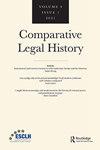Editorial
IF 0.5
Q2 LAW
引用次数: 0
Abstract
This journal aims to offer a contribution to the literature on comparative legal history. It gathers scientific studies and reviews of monographs that deal with law across time and space. This journal is part of the wider efforts of the European Society for Comparative Legal History (ESCLH) and it aims to display the work by scholars from across the globe. Issue 1 of Volume 11 presents three scientific studies that engage in comparative legal historical exercises. The first article, by Miriam Jensen Tveit and Helle Vogt, takes readers to towns in medieval Denmark and Norway, exploring regulations on urban poverty and the personae miserabiles (deserving poor). The comparative approach deals with jurisdictions, but also with the nature of rules, be it municipal or related to the church. The study further assesses the Scandinavian experience in light of the general European trends. The second article, by Rauna Kuokkanen, likewise explores Scandinavia. The focus is on the Sámi people and their interaction with land. The author invites readers to revisit the understanding of ownership. The study extends through the sixteenth to nineteenth centuries, allowing readers to explore the different shifts in the relationship with land, including exclusion, dispossession and racialization. The third article, by Đoàn Thanh Hải and Đoàn Thi ̣ Phương Diệp, continues looking at the pillar offered by property. The authors study the ‘điển’ in ancient Vietnamese society, extending the attention to other parts of the Sinosphere. The article then alerts on the broad range of uses of điển, and engages in an analysis of the functionalist approach by nineteenthand twentieth -century French academics and Frencheducated Vietnamese scholars. The article therefore invites for methodological insights into comparative legal history. The three scientific studies ultimately help demonstrate that comparisons in time and space can help unveil to a broader extent why events took place and not only what events took place, as pointed by David Ibbetson in the first issue of this journal. The book reviews section of Issue 1 of Volume 11 presents nine monographs that ought to be of interest for scholars who engage in comparative legal historical exercises. The first book reviewed deals with the history of international law, looking at the ways in which historians and international law scholars can help unveil the paths that were followed. The second book reviewed looks at the growth of representative institutions in Western Europe. It explains the power struggle between different actors in a multiplicity of jurisdictions, showing the materialization of representative institutions through strong central authorities. The third book reviewed broadens the understanding of the School of Salamanca. The authors’ work with source materials helps confirm the transatlantic dimension of Salamantine scholars, impacting legal thought in Europe and beyond.编辑
本期刊旨在为比较法律史文献做出贡献。它收集了关于跨越时间和空间的法律的科学研究和专著评论。本期刊是欧洲比较法律史学会(ESCLH)更广泛努力的一部分,旨在展示全球学者的工作。第11卷第1期介绍了三项从事比较法律历史研究的科学研究。Miriam Jensen Tveit和Helle Vogt的第一篇文章将读者带到中世纪丹麦和挪威的城镇,探讨关于城市贫困和悲惨人物(应得的穷人)的规定。比较法涉及管辖权,但也涉及规则的性质,无论是市政规则还是与教会有关的规则。该研究根据欧洲的总体趋势进一步评估了斯堪的纳维亚的经验。Rauna Kuokkanen的第二篇文章同样探讨了斯堪的纳维亚半岛。重点是萨米人及其与土地的互动。作者邀请读者重新审视对所有权的理解。这项研究贯穿了十六至十九世纪,使读者能够探索与土地关系的不同转变,包括排斥、剥夺和种族化。第三篇文章,作者:德昂丹ả我和丁ệp、 继续关注房地产提供的支柱。作者研究了ể在古代越南社会,将注意力扩展到了中国领域的其他部分。这篇文章随后提醒人们注意dj i的广泛用途ển、 并分析了十九世纪和二十世纪法国学者和受过法国教育的越南学者的功能主义方法。因此,这篇文章邀请我们对比较法律史进行方法论上的见解。正如David Ibbetson在本杂志第一期中指出的那样,这三项科学研究最终有助于证明,时间和空间的比较有助于更广泛地揭示事件发生的原因,而不仅仅是发生了什么事件。第11卷第1期的书评部分介绍了从事比较法律历史研究的学者应该感兴趣的九本专著。回顾的第一本书涉及国际法的历史,着眼于历史学家和国际法学者如何帮助揭示所走的道路。第二本书回顾了西欧代表性机构的发展。它解释了多个司法管辖区内不同行为者之间的权力斗争,显示了通过强大的中央当局实现代表性机构。第三本书评拓宽了对萨拉曼卡学派的理解。作者对原始材料的研究有助于证实萨拉曼廷学者的跨大西洋维度,影响欧洲及其他地区的法律思想。
本文章由计算机程序翻译,如有差异,请以英文原文为准。
求助全文
约1分钟内获得全文
求助全文
来源期刊
CiteScore
1.70
自引率
0.00%
发文量
20
期刊介绍:
Comparative Legal History is an international and comparative review of law and history. Articles will explore both ''internal'' legal history (doctrinal and disciplinary developments in the law) and ''external'' legal history (legal ideas and institutions in wider contexts). Rooted in the complexity of the various Western legal traditions worldwide, the journal will also investigate other laws and customs from around the globe. Comparisons may be either temporal or geographical and both legal and other law-like normative traditions will be considered. Scholarship on comparative and trans-national historiography, including trans-disciplinary approaches, is particularly welcome.

 求助内容:
求助内容: 应助结果提醒方式:
应助结果提醒方式:


